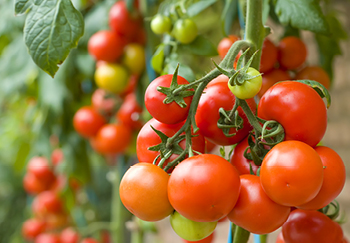Guide to Growing Tomatoes in Pots
February 5th, 2021 | Categories
Growing tomatoes in pots at home is a great way to start off growing your own tomatoes. Growing tomatoes in pots is a versatile, convenient, neat, and effective method, with its own nuances compared to growing in the ground or in grow bags. Rest assured though, the whole process from seed to harvest is still surprisingly simple and straightforward, even for beginners. It will reward you with a plentiful crop – a single plant can produce hundreds of tomatoes – all of your own making to enjoy during the growing season, from just a few seeds.
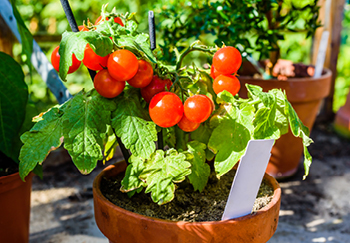
Tomatoes are simply one of the most popular, most enjoyed, vegetables around. There’s no better place to start off growing your own fruit and vegetables at home. While technically a fruit, because botanically, a fruit is a ripened flower ovary and contains seeds (which a tomato is and has), it’s also a vegetable, because we consume and consider it as one. Onwards, for simplicity we will refer to it as a fruit since we are talking about the fruit produced by a plant. There are many different varieties of tomato from sweet cherry tomatoes, to plum, to super-sized full-flavoured beef tomatoes. Whatever variety you wish to grow this guide will give you a good steer on what to do from seed all the way to harvest.
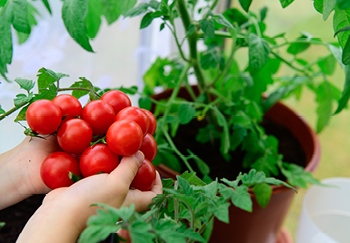
The great thing about growing tomatoes in pots is the flexibility offered. You can place your pots anywhere around the garden or patio, or balcony, or anywhere space is at a premium – even if there’s no garden at all. An advantage of using pots is that you can fill them with nutrient rich and fresh potting compost to give your plants the best start free of disease or waterlogged, overly compacted soil. If there’s a drop in temperature or high winds, you can move them to warmer and better sheltered areas in a snap.
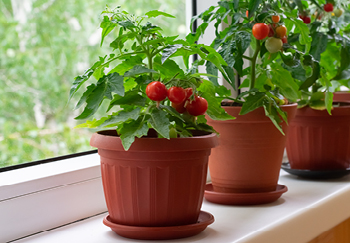
Let’s get started! Read through our step-by-step guide to growing tomatoes in pots, below.
Why You Should Grow Tomatoes in Pots at Home
It’s easier than you might think, it’s cheaper, the tomatoes are much more flavoursome, richer in nutrients, it’s better for the environment, and it’s better for you. Enough said or would you like to know more? OK more it is!
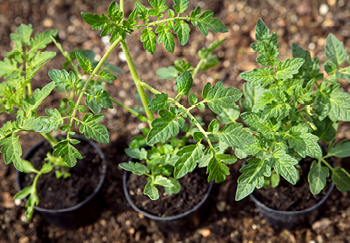
Did you know tomatoes in supermarkets are mass-grown in soilless environments with artificial fertilisers injected into them? This is to guarantee yields, shelf-life, and disease resistance year-round. Tomatoes also need good sun to grow which is at a premium in many regions of the UK, so we do a lot of importing. Thus, the tomatoes must survive longer so they can reach us still fresh. While all this is perfectly safe, it comes at the expense of other qualities like flavour and texture, even nutrients. They are also typically harvested before they have fully ripened. If you compare that to how they would grow naturally, the kind you’ll grow yourself, and actually eating them when they are ripe, the flavour is night and day – how a tomato should be enjoyed.
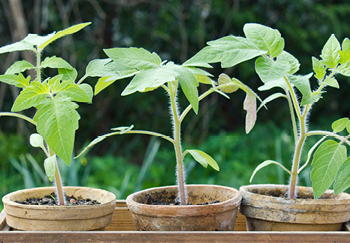
Additionally, homegrown tomatoes are known to be healthier with higher levels of the pigment ‘Lycopene’. Lycopene has been shown to help unclog blocked arteries and is thought to be a reason the Mediterranean diet is so healthy. This is simply because they are grown properly, as intended.
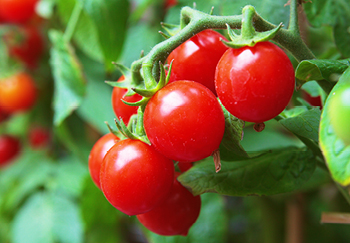
There’s more, a single plant can produce hundreds of tomatoes in a season, so it can pay for itself many times over. You can save the seeds from your tomatoes and grow them again next year too.
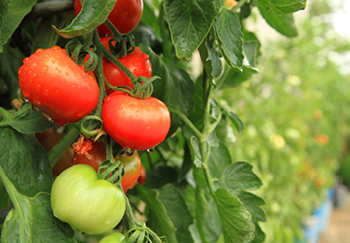
What Variety of Tomatoes Should You Grow in Pots
There are a few main varieties of tomato from sweet cherry tomatoes, to plum, to super-sized full-flavoured beef tomatoes. You can grow all of these types in pots, so why not choose one or two varieties you most enjoy and how you will use them:
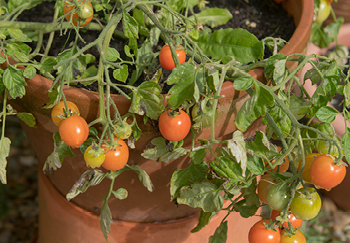
- Classic
The familiar, round variety and the most popular type of tomato. They’re the all-rounder; good for salads, grilling, baking, or frying.
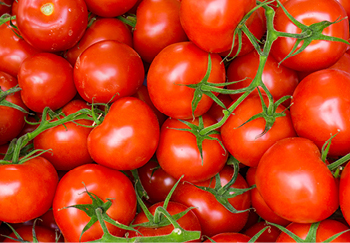
- Cherry
Cherry tomatoes are the smallest tomato but with an intense, sweet flavour. Most cherry tomatoes are red, but golden, orange, and yellow colours also exist. Cherry tomatoes are delicious eaten whole and raw; indeed, they are often added to salads, or cooked and added to pasta dishes.
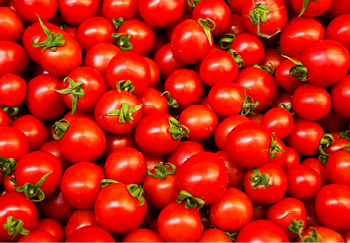
- Plum
These have the distinctive oval shape, with a firmer flesh, fewer sees and less liquid in their centre. Because they are less watery, they are the natural choice for pizza and pasta sauce, and their fleshy texture makes them great for barbequing too. Flavour-wise, they are sweet but typically not as much as cherry tomatoes.
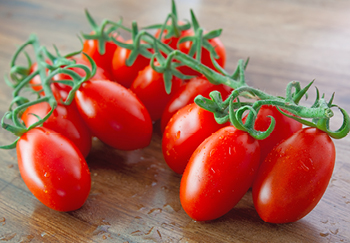
- Beef
One of the largest varieties in size, sometimes displaying pronounced ribbing, their size and shape make them excellent for stuffing and baking whole in the oven. They have a classic tomato flavour, sometimes sweet.
Each of the main varieties have their own shape, flavour, and best use cases as above. Additionally, each has its own subset of varieties within, such as Cherry Sungold, and Plum Roma San Marzano. We won’t get into listing them all, as that could fill a few pages on its own, but something to be aware of when choosing your seeds or young plants so you get exactly what you want.
One thing to note, in doing your own research you may come across the terms ‘bush/determinate’ and ‘cordon/indeterminate’. This refers to the type of tomato plant. Bush or determinate types grow like a bush, more outwards than upwards. Cordon or indeterminate, grow upwards – over two metres – and are what many people would recognise as the classic type of tomato plant you see with supporting stakes. Both are suitable for pot growing and our guide will address any key points you need to know for both types.
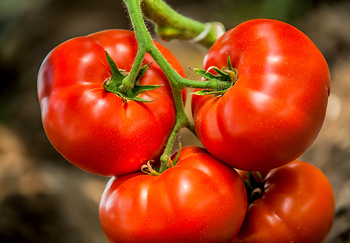
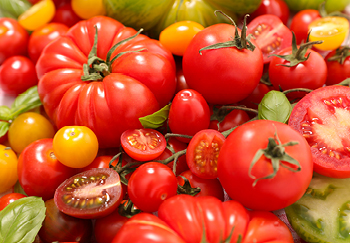
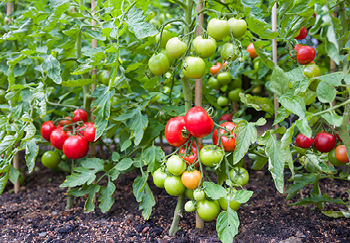
How to Start Growing Tomatoes in Pots
To grow tomatoes successfully in pots, it pays to be prepared and know steps to successfully pot growing tomatoes, so you can maximise your harvest while minimising any issues and effort. If growing your tomatoes from seed, there are a few more steps to consider before potting and transferring to the final large pot. Please visit our other guide – How to Grow Tomatoes, in particular the ‘Sowing’ section – which details how to grow from seed until the point of transferring each plant to their own pot. Once you have healthy young plants, come back here, and follow the steps outlined below. If buying young tomato plants, you are already at the stage to get stuck in and plant in your pots.
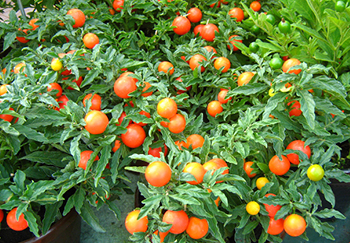
Before you get planting, the main thing to be aware of if growing tomatoes in pots is that you need a fairly large size of pot. The larger the pot, the easier it will be to look after the plants. You also must be careful with watering. Pots, and the compost within, sit above ground, naturally they will dry out quicker than if you planted your tomatoes in the ground. Check the compost often, especially on sunnier days, as it could dry out in just a couple of hours. Over watering can lead to issues too, so ensure your pots are well draining. You can do this by ensuring there are drainage holes in the bottom and that the compost isn’t overly compacted.
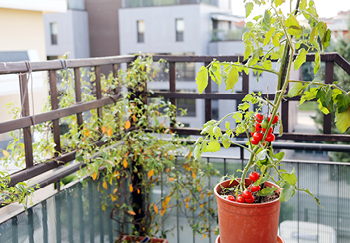
What You Will Need
When it comes to growing your own fruit or vegetables, preparation is the key to success. Before starting anything, gather some necessary items and materials:
- Pots
You only need one to get going but why not go for two or three, so you have a bountiful harvest? The larger the container the easier it will be to look after the plants and keep them healthy. Each plant ideally needs a 30cm minimum sized pot. Bush types look attractive in large hanging baskets too but will need frequent watering – and tomatoes are thirsty as it is.
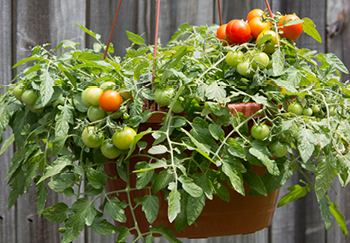
- Tomato Plants
It’s more fun and easier than you might think growing from seed, and you can select the exact type of tomatoes you want to grow. Alternatively, young plants are available to buy and do the job just as well, also reducing some of the time and effort needed overall.
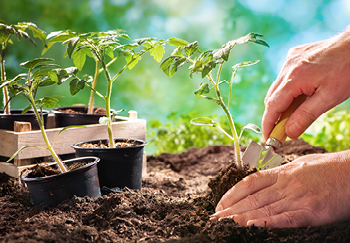
- Compost
Ideally, buy a high-quality, nutrient rich compost specifically for potting. Garden compost/soil for beds tends to be too heavy for containers and will compact. The more nutrients in your compost, the better start you’ll give your plants to go on and generate a plentiful harvest. Sometimes you may be limited to a multi-purpose compost, which can differ in their nutrient balance, so try to buy with that has less nitrogen overall.
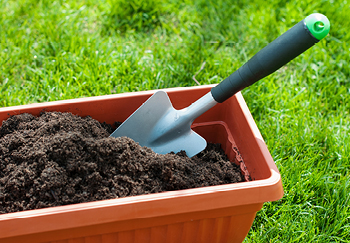
- Hand Fork, Trowel and Watering Can
For digging and loosening the compost and watering.
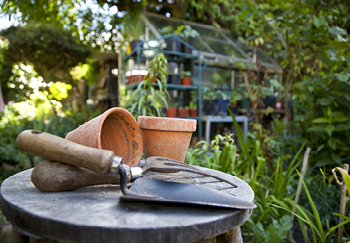
- Stakes
Something like a bamboo cane that you support the main stem of the tomato plant with.
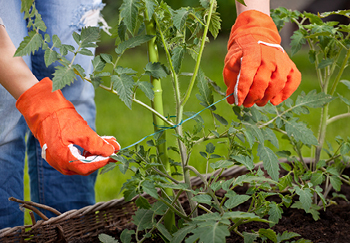
Pot Position & Soil/Compost
No matter if tomatoes are planted in the ground, in pots, or grow bags, they require a rich fertile soil or compost. Tomatoes are sub-tropical plants, so they love the sun and warmth, which means placing your pots where they will get full sun for as long as possible each day, in a position that also offers shelter and protection, such as against a wall or fence. The warmer the spot the faster the process will go. Be aware though that they can burn, so watch out for any extremely hot days. They’ll also need sufficient water, drawn up through the soil, but can’t be waterlogged, so it’s crucial to have ample drainage holes in your pots to prevent this. With pots, because planting is done above ground, the compost can dry out quickly, so be sure to water often, check repeatedly on sunny days as the soil can dry out quickly in just a couple of hours. If there’s 8-10 hours of sun, then that’s potentially four to five waterings – something to be aware of.
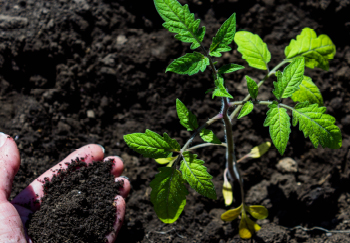
Step 1 – Water Plants & Fill Your Pots
Water your plants while still in their original pots so they are well hydrated before being transferred into their final growing pots. Then, fill your pots with compost to about an inch from the rim.
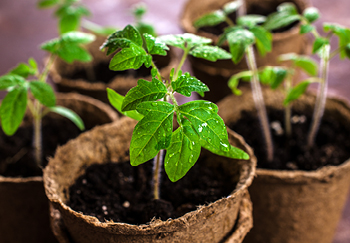
Step 2 – Planting
Now for the exciting bit, planting! Remember, only plant when they are ready to go outside when the nightly frosts have passed, usually sometime in May depending on your area. Water the compost, and then dig a deep hole for the plants and transfer them in. Replace the compost you just dug out and evenly spread. Remove any small and very low-lying stems from the main stem.
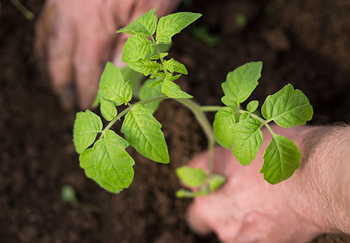
Step 3 – Staking
Cordon tomatoes need support to grow tall and you help them to do by staking a bamboo cane, for example, into the soil behind the plants, and, as they grow taller, tie to the stake with twine. You can use one, two or three steaks per plant (three is quite common as they get taller), there is no strict rule so long as the plants are supported because they cannot grow tall on their own.
Bush types require no staking.
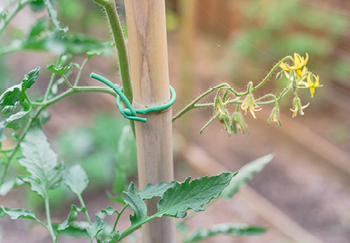
Watering & Feeding
Tomatoes generally are thirsty and hungry plants. As mentioned, the key to watering in pots is to be consistent. This helps to avoid splitting fruit, and Blossom End Rot (which comes from a lack of calcium). So, water little and often. On some very sunny and hot days you may need to water repeatedly as the pots can dry out in just a couple of hours, but do not waterlog. Having holes in your pot will help to prevent this. Feed weekly with a high-potash fertiliser or liquid tomato feed once the plants start to flower. If there is a lack of nutrients your tomato will produce more leaves and fewer fruits. Avoid any high nitrogen fertilisers as this will encourage more leaves than fruit to grow.
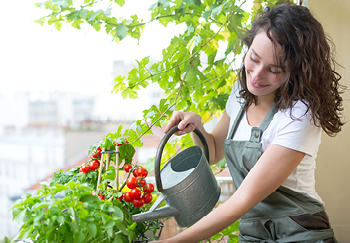
Pruning & Ongoing Care
Your plants will eventually require stopping (halting upward growth) and pinching out (removing side-shoots). A combination of Stopping and Pinching out is done to control the height of the plant and get it to focus on the existing tomatoes rather than continuous upward growth. To stop the plant simply cut the top after four or five trusses (smaller stems where flowers and fruit develops) have formed. You can start pinching out at his point too. Look for any little tips that start to grow out from between the main stem and trusses and pinch them out. It is quite easy to do but should be done gently to avoid any damage to the plant.
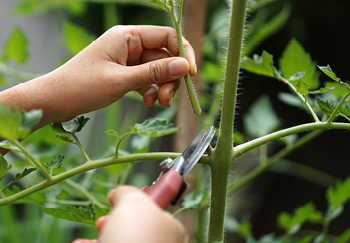
Also, when the first tiny fruits begin to appear, strip away the leaves underneath to allow light and air to reach them better. They can become quite thick with leaves, so it is important to allow airflow which in turn protects against tomato blight.
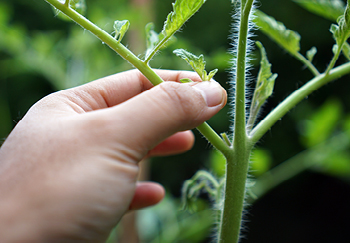
Tomatoes can suffer from some problems but knowing what to look out for will put you ahead of the curve in keeping your plants healthy all season:
- Tomato Blight
This is a disease that causes fruit and foliage rot, most caused by wet, damp weather and conditions, and poor ventilation. Ensuring the soil is well-draining and the leaves are picked will help to protect against this. It’s not as common on tomatoes grown in greenhouses.
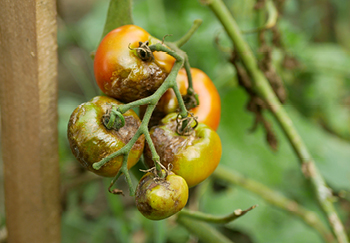
- Fruit Problems
Blossom End Rot (a dark patch at the base of the fruit and ruining the taste), Splitting Fruit (it splits open) and Blossom Drop (the flower bud falls off) are all caused by irregular watering, or overwatering. Follow a regular watering routine to the base of the plants, not their leaves, and it should ensure none of these problems happen.
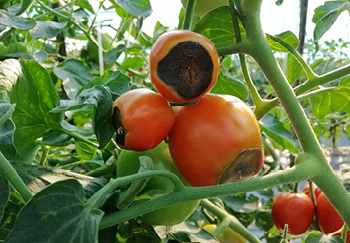
- Pests
There are a few pests that can ruin your plants, such as greenfly, whitefly, and aphids. Thankfully, plenty of repellents exist which can be bought to protect your tomatoes. Spray as soon as you notice them.
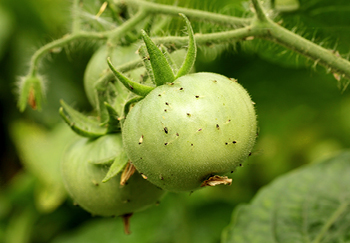
Harvesting
Congratulations on getting to this stage – you’ve successfully grown your own tomatoes in pots! Pick the fruit when they are ripe. Ripe, homegrown tomatoes taste so good, you won’t believe the difference. And you did it all yourself! Different varieties will grow and ripen at different times, and tomatoes on the same plant can also naturally ripen at different times too. To know when they are ripe and harvest, be sure to know the specific signals for your tomatoes, typically a colour and firmness change. Start picking at this stage. Healthy plants will carry on producing fruit until a noticeable drop in temperature, eventually dying when the first frosts of winter set in. If you’d like to save the seeds for next season revisit our other guide – How to Grow Tomatoes, in particular the ‘Actions for Next Year’ section – for the steps to achieve this. If you didn’t this time around give it a try, you can always buy young plants later if it doesn’t work out.
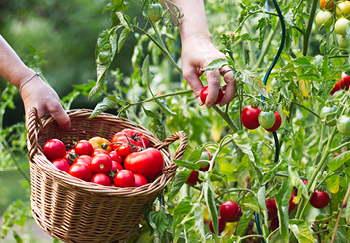
And That’s How to Grow Tomatoes in Pots
If you haven’t already, you’ll soon be well on your way to growing your own plentiful harvest of deliciously fresh tomatoes at home in pots. It’s easy and convenient for most people, even beginners, and can provide you with just as much fruit as planting in the ground or with the aid of a greenhouse. The versatility of growing tomatoes in pots is a particular appeal for most as they are easily moved around to sunnier spots, or brought inside if too cold at night. Give it a try.
